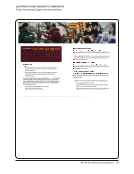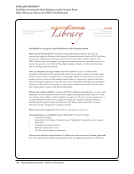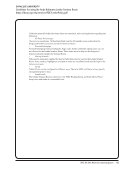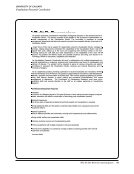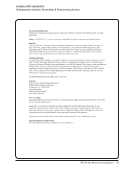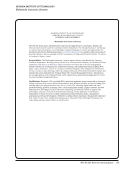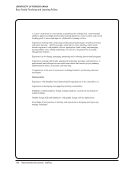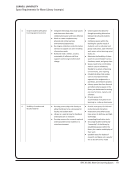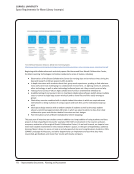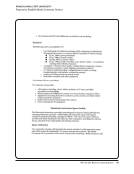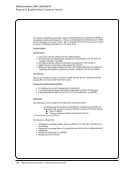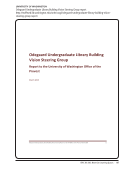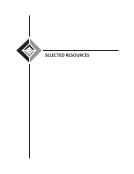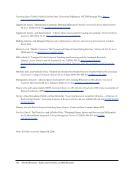SPEC Kit 342: Next-Gen Learning Spaces · 33
paraprofessionals—but there are changes in our staffing profile due to new learning spaces. Also, the combined
administrative units at the Engineering and Education libraries include positions such as instructional designers and
other traditionally non-library roles. They were originally housed in separate support departments for the school/college,
but now are part of the combined units that are led by the libraries.
Added a librarian position to support new programs in the Research Commons. Significant numbers of staff and
librarians participate in the management of the Active Learning Classrooms, including assessment, assignment,
tech support.
Additional instructional responsibilities have been incorporated into staff and librarian positions.
Also an increase and reliance on student staff, especially at a higher skill set, i.e., graduate student “consultants.”
Technologists/instructional support/statisticians are all coming on board and not in the traditional “support staff” mold.
Although we do not have any shared positions with external units, we have experienced a higher level of cooperation
with external units. Also, we are in the early stages of developing an emerging technologies position for one of
the libraries.
Among others, new positions have been added specifically in the area of instructional support, and these positions have
responsibility for developing, assessing, and managing some library learning spaces.
As we offer more specialized technologies and programs in our learning spaces we find that we need to hire experts
in these areas. They are not necessarily traditional library staff (librarians, archivists, curators, or support staff). We
have a Coordinator for Visualization who holds a PhD in Human Computer Interaction, and a coordinator for our Media
Commons who is an educational technologist.
Fine Arts: Librarians are embedded in departments and have teaching and office hours there.
In order to ensure that the librarians were proficient in the technology provided in the new learning space, we brought
on a support staff to focus on library staff IT training for a year.
More student assistants, additional Circulation/Information Desk staff for additional hours
Our Facilities and Support Services staff are responsible for checking the group studies to wipe down the white-board
walls. They also open and close walls in our technology classes.
Some new learning spaces are staffed in part by student employees.
Some OIT staff offices are located in the library and positions have direct responsibility for certain services in the library.
Staff have had to take on a small level of extra work in scheduling and configuring the class space and providing
maintenance for laptop computers in preparation for the instruction sessions.
Staff person became responsible for security into the Honors study area. Circulation staff are responsible for group study
room and equipment checkout.
This question implies a direct cause-and-effect. In many cases, learning spaces have evolved and jobs have evolved with
them. In the case of the Media Commons and the Scholarly Commons, new positions were created to manage them for
some positions, we recruited from outside our organization, and for others, we filled from within.
To better support our spaces and provide services that students and faculty need, every position within our User
Services department has been reviewed and revised. An increase in knowledge of technology—computer software,
multimedia equipment, AV equipment and software—has been built into those positions that we have recently filled
and staff trainings have increased so that all staff are comfortable assisting patrons. A greater percentage of time has
paraprofessionals—but there are changes in our staffing profile due to new learning spaces. Also, the combined
administrative units at the Engineering and Education libraries include positions such as instructional designers and
other traditionally non-library roles. They were originally housed in separate support departments for the school/college,
but now are part of the combined units that are led by the libraries.
Added a librarian position to support new programs in the Research Commons. Significant numbers of staff and
librarians participate in the management of the Active Learning Classrooms, including assessment, assignment,
tech support.
Additional instructional responsibilities have been incorporated into staff and librarian positions.
Also an increase and reliance on student staff, especially at a higher skill set, i.e., graduate student “consultants.”
Technologists/instructional support/statisticians are all coming on board and not in the traditional “support staff” mold.
Although we do not have any shared positions with external units, we have experienced a higher level of cooperation
with external units. Also, we are in the early stages of developing an emerging technologies position for one of
the libraries.
Among others, new positions have been added specifically in the area of instructional support, and these positions have
responsibility for developing, assessing, and managing some library learning spaces.
As we offer more specialized technologies and programs in our learning spaces we find that we need to hire experts
in these areas. They are not necessarily traditional library staff (librarians, archivists, curators, or support staff). We
have a Coordinator for Visualization who holds a PhD in Human Computer Interaction, and a coordinator for our Media
Commons who is an educational technologist.
Fine Arts: Librarians are embedded in departments and have teaching and office hours there.
In order to ensure that the librarians were proficient in the technology provided in the new learning space, we brought
on a support staff to focus on library staff IT training for a year.
More student assistants, additional Circulation/Information Desk staff for additional hours
Our Facilities and Support Services staff are responsible for checking the group studies to wipe down the white-board
walls. They also open and close walls in our technology classes.
Some new learning spaces are staffed in part by student employees.
Some OIT staff offices are located in the library and positions have direct responsibility for certain services in the library.
Staff have had to take on a small level of extra work in scheduling and configuring the class space and providing
maintenance for laptop computers in preparation for the instruction sessions.
Staff person became responsible for security into the Honors study area. Circulation staff are responsible for group study
room and equipment checkout.
This question implies a direct cause-and-effect. In many cases, learning spaces have evolved and jobs have evolved with
them. In the case of the Media Commons and the Scholarly Commons, new positions were created to manage them for
some positions, we recruited from outside our organization, and for others, we filled from within.
To better support our spaces and provide services that students and faculty need, every position within our User
Services department has been reviewed and revised. An increase in knowledge of technology—computer software,
multimedia equipment, AV equipment and software—has been built into those positions that we have recently filled
and staff trainings have increased so that all staff are comfortable assisting patrons. A greater percentage of time has









































































































































